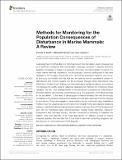Files in this item
Methods for monitoring for the population consequences of disturbance in marine mammals : a review
Item metadata
| dc.contributor.author | Booth, Cormac G. | |
| dc.contributor.author | Sinclair, Rachael R. | |
| dc.contributor.author | Harwood, John | |
| dc.date.accessioned | 2020-03-04T13:30:04Z | |
| dc.date.available | 2020-03-04T13:30:04Z | |
| dc.date.issued | 2020-02-28 | |
| dc.identifier | 266717354 | |
| dc.identifier | 2556a0bb-eece-43f6-b758-399167344668 | |
| dc.identifier | 85082556815 | |
| dc.identifier | 000517581200001 | |
| dc.identifier.citation | Booth , C G , Sinclair , R R & Harwood , J 2020 , ' Methods for monitoring for the population consequences of disturbance in marine mammals : a review ' , Frontiers in Marine Science , vol. 7 , 115 . https://doi.org/10.3389/fmars.2020.00115 | en |
| dc.identifier.issn | 2296-7745 | |
| dc.identifier.other | Bibtex: 10.3389/fmars.2020.00115 | |
| dc.identifier.uri | https://hdl.handle.net/10023/19596 | |
| dc.description | This work was sponsored by the Office of Naval Research: Marine Mammal Biology Program, under award N000141612858. | en |
| dc.description.abstract | Assessing the non-lethal effects of disturbance and their population-level consequences is a significant ecological and conservation challenge, because it requires extensive baseline knowledge of behavioral patterns, life-history and demography. However, for many marine mammal populations, this knowledge is currently lacking and it may take decades to fill the gaps. During this time, undetected population declines may occur. In this study we identify methods that can be used to monitor populations subject to disturbance and provide insights into the processes through which disturbance may affect them. To identify and address the knowledge gaps highlighted above, we reviewed the literature to identify suitable response variables and methods for monitoring these variables. We also used existing models of the population consequences of disturbance (PCoD) to identify demographic characteristics (e.g., the proportion of immature animals in the population, or the ratio of calves/pups to mature females) that may be strongly correlated with population status and therefore provide early warnings of future changes in abundance. These demographic characteristics can be monitored using established methods such as visual surveys combined with photogrammetry, and capture-recapture analysis. Individual health and physiological variables can also inform PCoD assessment and can be monitored using photogrammetry, remote tissue sampling, hands-on assessment and individual tracking. We then conducted a workshop to establish the relative utility and feasibility of all these approaches for different groups of marine mammal species. We describe how future marine mammal monitoring programs can be designed to inform population-level analysis. | |
| dc.format.extent | 18 | |
| dc.format.extent | 4267723 | |
| dc.language.iso | eng | |
| dc.relation.ispartof | Frontiers in Marine Science | en |
| dc.subject | Marine mammals | en |
| dc.subject | PCoD | en |
| dc.subject | Monitoring | en |
| dc.subject | Disturbance | en |
| dc.subject | Populations | en |
| dc.subject | Trends | en |
| dc.subject | Demography | en |
| dc.subject | GC Oceanography | en |
| dc.subject | QH301 Biology | en |
| dc.subject | SDG 14 - Life Below Water | en |
| dc.subject.lcc | GC | en |
| dc.subject.lcc | QH301 | en |
| dc.title | Methods for monitoring for the population consequences of disturbance in marine mammals : a review | en |
| dc.type | Journal item | en |
| dc.contributor.institution | University of St Andrews. School of Biology | en |
| dc.identifier.doi | 10.3389/fmars.2020.00115 | |
| dc.description.status | Peer reviewed | en |
This item appears in the following Collection(s)
Items in the St Andrews Research Repository are protected by copyright, with all rights reserved, unless otherwise indicated.

